
 ANGELA KELLY
ANGELA KELLY







 ANGELA KELLY
ANGELA KELLY





 By Angela Kelly
By Angela Kelly
WE are now going into the main time of the year when many people in the UK think about living in a sunnier climate.
It’s completely understandable, of course, when our wet and chilly Autumn months give way to even colder and icier weather before Spring hits.
TV programmes showing the glories of life in the sun around the world are definitely feelgood viewing now.
According to a new survey, 54 per cent of us are thinking of living in another country with many citing the cheaper cost of living and others just wanting a better lifestyle and weather.
Spain has been named the best retirement destination by UK over50s for the 10th consecutive year while Portugal has overtaken France in distant second place.

Italy is fourth with South Eastern Europe (Greece, Romania, Serbia and Cyprus) fifth and the Far East - including China, Tahiland, Japan, Hong Kong, Singapore and Philippines – sixth.
America and Australia have all improved their rankings over last year at sevenths and eighth and ninth and 10th places go to New Zealand and Turkey.
Anyone over-50 thinking of leaving the UK for warmer climes permanently, though, needs to heed the advice of life insurance company Canada Life.
They warn of the importance of checking whether your destination has a reciprocal agreement on the state pension. Otherwise, you may end up missing out financially as it could be frozen at whatever amount it was set at when you first left the UK.
While the Government has struck individual deals with some countries – Spain and other EU countries were involved in a state pension rights’ deal during Brexit negotiations – others like Canada, Australia, India and many parts of the Caribbean don’t have deals. Rising inflation might make this area of vital importance.
As a spokesman for Canada Life commented: “Retiring abroad is not a step to be taken lightly. The financial considerations are vast, such as thinking about the impact of currency exchange rates, local tax rules and whether state pensions will keep pace with the cost of living.”
I’m afraid we may get blinded with the potential sunshine on the matter of finances when those hotspots beckon for a better life as we sit at home in the UK.
Plainly, we need to keep our eyes wide open – and do the maths.
SPORT can bring couples and families together but it can also drive them apart.
I don’t think the early signs were too good when one young Australian woman caught her new husband watching a rugby match on his phone on their wedding day!
He had propped up the phone against their three-tiered wedding cake. Then, adding insult to injury, he did the same thing at her brother’s wedding later.
It’s hard to imagine how their married life will go after he’s shown where his real interest in life lies.
I’ve always worried about bridegrooms in particular who insist on planning a wedding around sporting dates. Although everyone is entitled to enjoy their pastimes, you’re getting married to the supposed love of your life, mate, so how about showing a bit of early commitment?
IF there is one aspect of our lives that has undergone a dramatic makeover in the last couple of years it’s working from home.
Prior to 2020, working from home was the exception rather than the rule but, thanks largely to Covid 19, it has undergone a dramatic surge.
Before the pandemic, staff went into the office an average of 3.8 days a week but by April, 2020, 46.6 per cent of people in employment did some work at home.
Post-lockdown, many companies wanted to get staff back into the office, sometimes with hybrid working where employees split their work between home and office. And it may now be that this form
of flexible working is the way forward; 47 per cent of American workers prefer this model.
Productivity is the obvious measure of any method of working and working from home certainly seems to have a positive result for many companies. In fact, many people reported being more productive at home than in the office.
However, there are naturally some down-sides.
In the same survey, 81 per cent of younger workers said they would feel isolated without more time in the office and 60 per cent reported they felt less connected to colleagues. Loneliness could certainly be a factor and, for some, there were just too many distractions at home.

However, the lack of a commute and its possible stress, the relaxed “dress code”, flexible scheduling and the ability to look after family, pets and ageing relatives better were all identified as huge advantages.
One interesting side-effect is that many people decided to move house when proximity to work was no longer a requirement.
To be realistic, working from home is not for everyone, either because their job could not be run from home efficiently or simply because they prefer to be with other people.
It is a fact, though, that we have crossed a line in the working world and it will be fascinating to see where this journey now takes us.
THE very moving time around the Queen’s death and during the mourning period revealed much about both this nation and people in other countries.

The genuine sadness at her passing was hard to miss. People loved her and admired the way she tackled the role of monarch from being a young woman into older age.
The affection for her from people of other nations was also heartwarming. Whatever thoughts there are about monarchy, there appeared to be real affection for Her Majesty.
What the funeral itself and all the tradition involved also proved is that the way we handle this sort of occasion is unparalleled.
The stoic precision of individuals and horses, the grandeur, the sheer spectacle proved once more that Brits really do this best.

There’s something strangely mesmerising about a pool of bubbling mud, the rhythmical gloop-gloop sound and the way the liquid earth shudders with each bursting bubble. I hold my breath as I pass through the cloud of sulphurous steam issuing from the valley floor and marvel at the barren landscape, stained in a palette of primeval colours from a myriad of minerals. No wonder the crew of Apollo 11 came here to Iceland to train for the Moon landings.
This chance to experience Iceland’s geothermal landscape is one of many good reasons why I booked a 12-day cruise with Silversea this summer from Reykjavik to London. I’ve always loved wild, unspoilt places and Iceland delivers by the bucket load. But after four full days on this extraordinary island, the itinerary also promised more dramatic scenery through a clutch of other Atlantic islands, as well as wildlife encounters, historic sites, and some appealing TV tie-ins. A varied itinerary that only a cruise can deliver.
Iceland is featured by several cruise operators but from previous experience, we knew we liked the luxury boutique feel of the Silversea fleet. A real treat after so many cancelled trips during the pandemic. In July 2022 when we travelled, passengers with up-to-date Covid vaccines – in other words, each one you are eligible for - were required to produce a negative Rapid Antigen
test within 72 hours of departure. We passed, but sadly our travelling companions didn’t and were given an immediate full refund by Silversea.
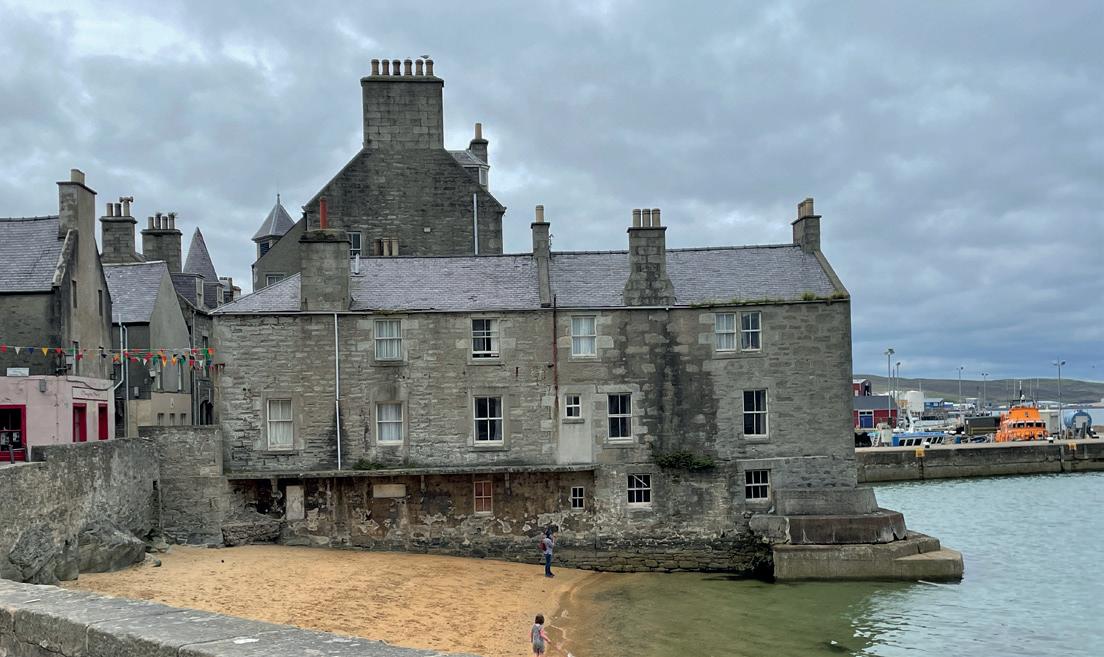
We travelled this time on Silver Whisper which carries 392 passengers in understated luxury, flying to Reykjavik with British Airways from London just as the record-breaking heatwave hit Britain. A welcome relief on our part as we packed layers of outdoor clothing for temperatures likely just to edge into double figures
Silversea voyages include all drinks, meals and tips as well as a good choice of free daily excursions, so there are only optional extras to pay for such as spa and bespoke experiences. Our 12day cruise included two formal nights, but gentlemen can choose dinner suit, dark suit, or blazer and tie, or to dine casually at the pool deck grill.
Every passenger enjoys butler service with each butler assigned to a small group of suites, but it’s not nearly as intimidating as it sounds. Vimal, our butler, supervised the daily cleaning of our accommodation, kept our minibar stocked with our choice of drinks, and generally took care of any requests. He wasn’t there to unpack our smalls, although ‘help with packing’ was advertised for those in need of a hand before return.
In Iceland, we chose four excursions to give us a real feel for the island’s varied landscape and wildlife. The rugged western fjords and the geothermal landscape of the north, as well as a guided hike to a plateau high above the east coast. In summer, birdlife
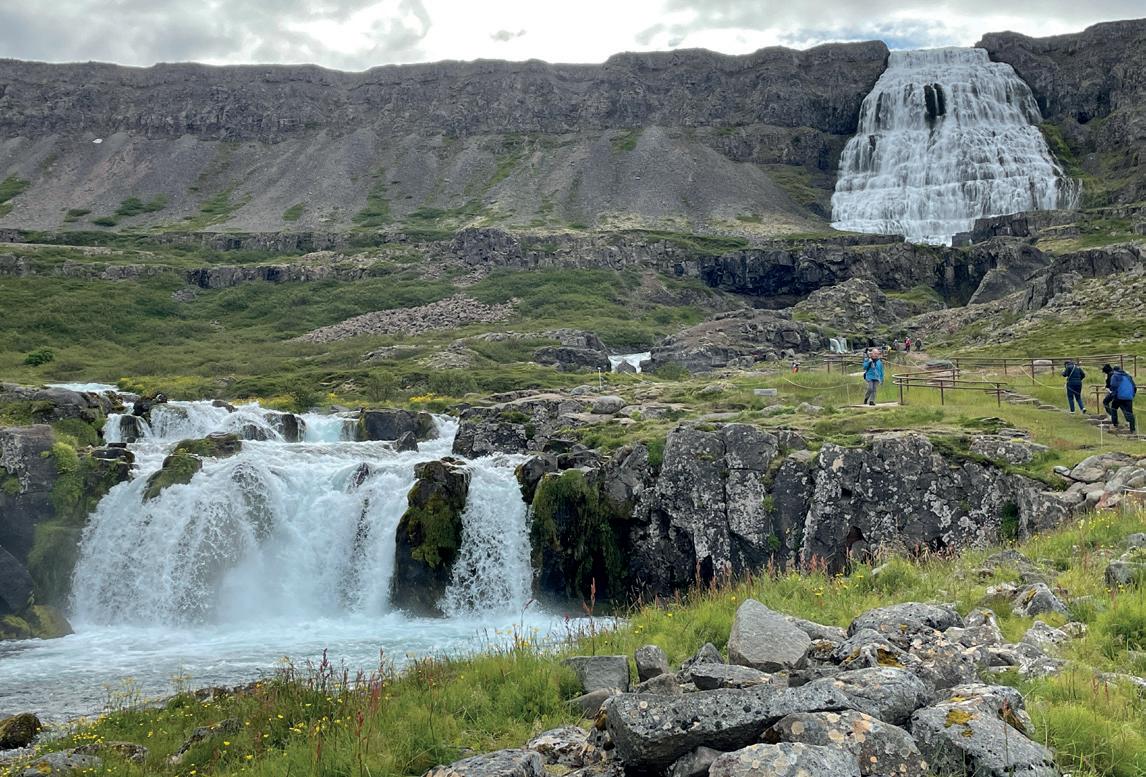
Silver Travel Advisor’s Gillian Thornton explores the unspoilt landscapes of the North Atlantic
ICELAND TO LONDON CRUISE WITH SILVERSEA
was everywhere from puffins and gannets to godwits, plovers and whimbrels. Not sure you’d know one? You will if you chose the nature excursions!
You’re never very far from tumbling water either in this extraordinary landscape, from cascading streams to the ‘mini Niagara’ of the powerful Godafoss waterfall where a 10th century king is said to have flung images of pagan gods into the water as the country adopted Christianity. Others Icelandic legends include sea monsters and strange beasts, still supposedly seen in recent decades!
After four days around Iceland and a relaxing sea day, contrasting islands followed in quick succession. The spectacularly rugged Faroes, setting for the Scandi crime series Trom and 007’s final scene in No Time to Die. The Shetland Islands too where we enjoyed scenery, seals and seabirds on a guided walk around a nature reserve, and browsed round Lerwick, setting for the TV detective series Shetland. And lastly, the Orkney Islands where my imagination went into overdrive amongst the Neolothic remains of Skara Brae village and the standing stones at the Ring of Brodgar.
Without exception, the local guides were excellent, teaching us about the Norse history that links not just these Atlantic islands but also our own island and France after Viking explorers set off from Norway in the ninth century. Who knew for instance, that the word ‘Viking’ actually means ‘adventurer’?
We loved the summer wildlife too. The humpback whales who obligingly put on a show beneath cloudless blue skies during our whale watching tour from Husavik, and the sight of thousands of puffins flying and fishing around their annual island nesting grounds. Seals basked on Scottish beaches, popping up at dinner beyond
the restaurant window, and Arctic terns put on spectacular fishing displays as they plummeted seawards to seize another snack.
From the Orkney Islands we sailed to another volcanic landscape, Edinburgh, the ancient volcano of Arthur’s Seat clearly visible above the city as we moored close to The Royal Yacht Britannia, another advantage of choosing a small ship that can access the inner harbour. Take a choice of city tours, visit the spectacular Rosslyn Chapel, or simply take the shuttle bus to explore independently.
Two relaxing sea days gave us time to enjoy the hospitality and facilities of Silver Whisper before an evening cruise up the Thames to our final mooring. The coloured lights of the Thames Barrier, the ‘Manhattan’ skyline of Canary Wharf, and the unmistakeable dome of the 02 Arena gave way to stately Greenwich Palace and the illuminated masts of the Cutty Sark. A very different ship but a fittingly maritime finale for our North Atlantic adventure.
Call the Silver Travel Advisors on 0800 412 5678 to book and to find out more about Silversea voyages. www.silvertraveladvisor.com


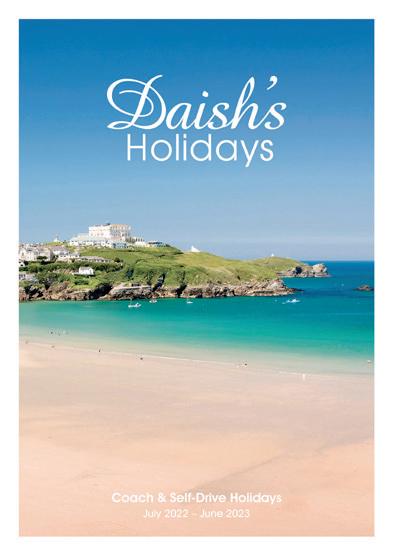



 Newquay Blackpool Lake District EastbourneScarboroughBournemouthTorquayIsle of Wight Weymouth
Newquay Blackpool Lake District EastbourneScarboroughBournemouthTorquayIsle of Wight Weymouth





















It disappeared under my grandfather’s favourite potted plant, gathered speed as it passed the piano. The tracks divided at the signal section. There was a platform where passengers stood – were they travelling to an exotic destination? This was our family electric train set which brought hours of delight, tilting on corners and chugging along a figure of eight track. Times change, toys morph into souped-up versions, dreams come true.
Fast forward to today and I’m one of the passengers standing on the platform in Vancouver. Resting on tracks before me, handsomely coated in a twin set of blue and gold with a beige lining and steel shoes, my train patiently sits. Bold, big, strong and inviting. This long convoy of carriages is ready to carry me on a cinematic voyage across part of Canada and through the solid heart of the Rockies. Aptly named The Rocky Mountaineer, a national treasure and one I would soon learn to be a steel wonder.
This procession of twenty carriages follows the first Passage to the West, from Vancouver, through Kamloops to Lake Louise/ Banff. The train will retrace the tracks laid by labourers including many Chinese immigrants who risked life and limb to carve a rail route through the darkness of rock to connect the west to Canada’s east. It was 1855 when the Canadian Pacific Railroad opened in a place renowned for fur trading and gold. And ever since then has proven to be a key catalyst in the development of the nation. It brought tourism and hotels along the route. Banff
Springs Hotel is one example and at the time required guests to present bank statements to prove they could afford to stay in such luxury.
Seat 32, coach CB03, I take my place onboard, my home for the next two days. The Gold Leaf class has two levels, the upper deck is stylish in cream, is light, airy and spacious. My squishy chair was like a lounge sofa, comfy and reclining and better still, heated to three settings, a lumber support to please your spine and a leg rest to treat your feet. Plenty of leg room. There’s even a mechanism to turn the two seats to face the window. Magic! And as for wheel chairs, these can be anchored into place. The foldaway tables are a perfect perch for the drinks and snacks which I soon realise are served at regularly intervals. All this framed by an oversized picture window, curved to form a domed roof to ensure uninterrupted views. Saudi princes, African royalty, Bill Gates and Morgan Freeman have all sampled these for size, on these very tracks. Adult children re-living childhood memories, multi-generational anniversary milestones, celebrations, The Rocky Mountaineer is near the top on many a bucket-list, including mine.
We sneak away from the platform with a piper heralding Bon Voyage. Our journey criss-crosses bridges, follows streams, and witnesses waterfalls throwing their weight. We look onto lakes
Jane Wilson fulfils her rail dream and is mesmerised by Canada’s natural beauty
edged with pretty chalets and moored houseboats. We peep into backyards. And where we see people, smiles and waves follow us. From time to time the highway runs parallel, a reminder of life’s hectic tempo in contrast to the genteel pace onboard. Leaves lick the windows, trees tap the roof as we snake around bends and eagerly watch for wildlife. We spot bear cubs deep in the woods below but sadly no grizzlies, goats grazing in the open fields, and elk show off close-by. We are transient visitors.
The sights continue as we step below to the dining area. This is the chance to share stories and exchange travel experiences. For solo travellers, this is a time to mingle and forge new acquaintances. I’m presented with a spoilt-for-choice menu. Breakfast is a fruit creation with a fluffy bakery item followed by a choice of seven dishes. Would it be spinach and cheese soufflé, avocado toast, Shuswap bacon breakfast skillet or berry parfait? Oh, the dilemma. There is a lift in the Gold Leaf cars for those requiring assistance or meals can be served to your seat. The toilets are also accessible.
Throughout my journey, onboard hosts provide fascinating facts and stories. According to my host, Travis, narratives and facts give context and meaning. They bring this vision to life and engage us. It’s not just a train journey but an experience, a personal interpretation. As we delight in the diverse landscapes, he points out the sheer walls of the Fraser Canyon and Avalanche Alley, perilous rapids at Hell’s Gate as well as describing the many ecosystems. Our overnight stay in Kamloops was the trading centre for the Shuswap people and also in this area are the unique landforms, known as the Hoodoos formed after the last ice-age.
On the second day Travis’ narrative becomes more detailed and I’m fascinated by the Spiral Tunnels, entering and then exiting to reversed views, evidence of the clever navigation of tunnelling through rock to gain height. “The amazing accomplishment is a perfect maze, the railway doubling back upon itself twice, tunnelling under mountains and crossing the river twice in order to cut down the grade”. In 1907 construction started, based on the tunnel system of Switzerland, taking 20 months to complete. The Upper Spiral travels through Cathedral Mountain, 3,255 feet long turning approximately 290 degrees to emerge 50 feet higher than entering. The Lower Spiral tunnels through Mount Ogden at 2,923 feet long and turns around 230 degrees emerging 56 feet higher. What an achievement!
The Continental Divide, a landmark on this route, is the highest point of our journey at 5,332 feet above sea level and separates the Pacific and Atlantic watersheds. At this height, there’s peppermint or ginger tea available for anyone with any hint of altitude sickness but there are no requests. We slow down at Craigellachie to acknowledge the exact place of the Last Spike driven into the ground in 1885 on Canada’s Transcontinental rail line. This leads us to our final stop in Banff, a popular tourist destination, which was named after Banffshire in Scotland and is part of the Banff National Park.
The Canadian Rockies has always been home to many indigenous people. Their nature and spirit lie in the mountains, their voices continue. And as we witnessed their lands, we listened in silence as we were told of their traditions and challenges, a subject begging me to explore after this trip.
This is the mysticism of nature unfolding before me. Here, the mountains steel your mind, lock your thoughts and uplift your spirit. It is like being suspended in time, in nature and drawn into their soul
and majestic wonder. Their sheer strength of presence soaring above as the locomotive clatters and cuts through ravines and tunnels. Clouds cloak the rocks like a thermal coat against the settled snow on the peaks. Trees add a feathery texture like furry dusters leaning into the steep, sharp escarpments to keep balance. Blasts of dazzling white patterns accentuate the seams and ridges of the rock faces which seems so vivid as they come into view from the darkness of the rocks’ tunnels.
At the back of the car on the lower level is the open-air platform, shiny chrome bars to mark our safety. The wind in your face, the smells of wet cedar, nature’s own aromatherapy. An orchestra of trees whizz past, like spindly strings shaped like cellos. And as we meander around bends we play catch up with the front carriage, turning the other way, there is the back!
The onboard executive chef caters for every diet and where possible sources food locally. He is eager to keep nutrition in mind too with the wellness trends of today. Lunch is a leisurely three-course affair. The starter is a sharing platter followed by a choice of six main course options including a vegan Sesame Soy Udon Bowl, an Alberta Striploin Steak and Lois Lake Steelhead Salmon. A yummy dessert rounds off the meal. Food is colourful and imaginative to reflect the journey. And to toast the occasion along the way, there are signature cocktails such as a Gin Rocky, liqueurs, spirits, British Columbia beers or ciders.
This is a two-day rail voyage capturing nature’s act during daylight hours with all the arrangements for the hotel overnight rests conveniently organised. We disembark as nature’s guests. Mountains don’t get old, we get wise. I’m richer from the experience, yet humbled. In awe and wonder, this route, The First Passage to the West, was pioneering, laying the foundation for cross country travel. This feat of engineering, so treacherously dangerous to achieve, gives such pleasurable experiences for many future adventures.
Who would think that a memory of a toy train set can metamorphosize into the experience of one of the world’s most iconic train adventures.
Take a look at www.silvertraveladvisor.com/holiday_type/rail/ to find more about the Rocky Mountaineer and call the Silver Travel Advisors on 0800 412 5678 to book.

WHEN Sue Barker retired as a TV presenter at Wimbledon this Summer the tears came from more than just her – the nation felt that we had lost something special.

Her great success on TV generally, although especially her associations with the annual tennis-fest at SW19, make us easily forget, however, just what a talented and successful tennis player Sue was. At one time in her career, she was ranked No.3 in the world.
Her tennis career started where she was born and brought up in Paignton, Devon. She was educated at a convent school and at the age of 10 in 1966 she was picked as one of two girls to receive free coaching from week-known tennis coach Arthur Roberts.
He had coached Angela Mortimer – the former world No.1 female tennis player – and was impressed with the slight blonde girl. In particular, he was impressed by her forehand, and when the period of the free coaching finished, he continued to coach her.
Roberts entered Sue, then in her teens, into tournaments abroad, giving her a one-way ticket and instructing her to win enough to pay for her ticket home! Roberts did, though, prove to be a supportive mentor and highly influential throughout her tennis career.
At just 16, young Sue was No.21 in the LTA rankings and Roberts advised her to move to America for to improve her development. Here, she was signed by Mark McCormack’s International Management Group (IMG).
She won her first top-level singles title in 1975, along with three additional titles, and reached her first Grand Slam semi-final at the Australian Open.
She won the German Open the following year and had the biggest victory of her career in 1976 when she won the French Open at the age of 20.
In 1977, Sue won two singles’ titles in San Francisco and Dallas and beat Martina Navratilova to reach the final of the Virginia Slims Tour Championships, where she lost in three sets to Chris Evert.
That year, she reached the semi-finals of the Wimbledon Centenary Championships, looking set to meet fellow Brit Virginia Wade in the landmark final. Unfortunately, she unexpectedly lost her semi to Betty Stove of the Netherlands who in turn lost to Wade.
After this disappointment, Sue continued her tennis career but was plagued by injuries and in 1978 her ranking dropped to world No.24. However, she still won three singles’ titles and reached three other finals in 1979 and won the final title of her singles’ career in 1980 at the Brighton International.
She won her last doubles’ title in 1982 at Cincinnati and played her last professional match in 1984 when injuries forced her to retire from tennis. In all, she had won 15 singles’ titles and 12 doubles’ titles with notable wins over famous players including Chris Evert, Billie Jean King Rosie Casals and Pam Shriver.
After a short break – and to the surprise of some tennis luminaries like Martina Navratilova who, on Sue’s retirement this year, said how shy she had been then – she began a broadcasting career in Australia.
Fortunately for the UK, in 1993 the BBC recognised both her broadcasting skills and her current tennis knowledge.
The following year, she started presenting coverage from the Wimbledon tennis championships, Unsurprisingly, her depth of knowledge about the game and about the life of touring tennis players and her natural warmth brought a fresh perspective to the coverage.
She knew so many of the players personally – many obviously liked her and chatted happily with such an old friend and viewers benefitted from such an informed, informal approach. She asked pertinent questions that added to viewers’ understanding of individuals and the game and made Wimbledon coverage more accessible and enjoyable.
John McEnroe put it beautifully succinctly on her final day when he told a tearful Sue that Wimbledon “just wouldn’t be the same anymore” without her.
Sue’s sunny smile and ready sense of humour, alongside her professionalism, also took her into other areas of broadcasting. She became the presenter of BBC’s very popular programme A Question of Sport and there was an outcry when she was replaced last year. Many viewers are still lobbying for her return.
She was awarded the MBE in 2000 for services to tennis and broadcasting and the OBE in 2016 for her services to sport, broadcasting and charity.

Sue has been happily married to landscape gardener and former policeman Lance Tankard since 1988 and the couple live in Stanton, Gloucestershire.
However, before she met Lance, Sue was in a relationship with famous Australian golfer Greg Norman. But it was when she got together with singer Cliff Richard that the British media went wild.
In her just published autobiography, Calling the Shots, she recalled how the relationship started when she met Hank Marvin and Brian Bennett from his backing group who were on tour and staying at her hotel when she was playing in Brighton.
She got them tickets to her match. Cliff, a huge tennis fan, got her number from them and called her asking her to go to the Shadows’ concert with him.
This was the start of a relationship that must have been hard to maintain for both of them. Sue was playing on the tennis circuit around the world and Cliff was fulfilling his own tour engagements in different countries.
The British press loved this romantic story of two famous names linked but the relationship only lasted a matter of months. As Sue states in her book:
“It felt to me like a friendship that had the potential to develop, rather than a significant romantic relationship, because we hadn’t taken it far – and I’m not just talking about sex.”
The long ago romance, though, has always struck a chord in the public psyche and there is no doubt there will be questions about her and Cliff when she tours the UK during October talking about her career and life in and out of tennis.
• For more information about her tour go to
Many conser vator y owners have installed additional heating but become concerned about rising energy bills. They may have considered a solid tiled roof this is where Sagars 365 can help.
Many conservatory owners have installed additional heating but become concerned about rising energy bills. They may have considered a solid tiled roof but been put off by the cost – this is where Sagars 365 can help.
Many conservatory owners have installed additional heating but become concerned about rising energy bills. They may have considered a solid tiled roof but been put off by the cost – this is where Sagars 365 can help.
you might expect. Typically costing 75% less than a solid tiled roof.A pol y ca r bon a t e roofed, lean to c o ns e r va t o r y star ts at just £1,899 including VAT.
The family-run Yorkshire based company use their revolutionar y insulation system to turn conser vatories into rooms that can be used ever y day of the year by minimising condensation, reducing noise in bad weather, reducing heat loss in winter by over 90% as well as keeping the heat out in summer. The cost is less than
The family-run Yorkshire based company use their revolutionary insulation system to turn conservatories into rooms that can be used every day of the year by minimising condensation, reducing noise in bad weather, reducing heat loss in winter by over 90% as well as keeping the heat out in summer. The cost is less than
The family-run Yorkshire based company use their revolutionary insulation system to turn conservatories into rooms that can be used every day of the year by minimising condensation, reducing noise in bad weather, reducing heat loss in winter by over 90% as well as keeping the heat out in summer. The cost is less than you might expect. Typically costing 75% less than a solid tiled roof.A polycarbonate roofed, lean to c o n s e r v a t o r y starts at just £1,999 including VAT.
you might expect. Typically costing 75% less than a solid tiled roof.A polycarbonate roofed, lean to conservatory starts at just £1,899 including VAT.
With interestfree credit you could spread the cost over 6 or 10 months (subject to approval). The work is typically completed in one day and you can choose either a tongue and groove PVC or premium plastered
With interest-free credit you could spread the cost over 6 or 10 months (subject to approval). The work is typically completed in one day and you can choose either a tongue and groove PVC or premium plastered finish.
With interestfree credit you could spread the cost over 6 or 10 months (subject to approval). The work is typically completed in one day and you can choose either a tongue and groove PVC or premium plastered finish.
Sagars 365 is a company that you can trust they have an overall ‘Excellent’ rating on
Trustpilot, they ’re a Which?
Trustpilot, they’re a Which?

Sagars 365 is a company that you can trust - they have an overall ‘Excellent’ rating on Trustpilot, they’re a Which? Trusted trader and offer a 10-year guarantee. All the work is carried out by Sagars in-house team. No deposit required. If you’re looking to keep your conservatory warm in winter and cool in summer, call Sagars 365 on 01484 823008 to arrange a free, no obligation survey and quote.



10 year guarantee. All the work is carried out by Sagars in-house team. No deposit required. If you’re looking to keep your conser vator y warm in winter and cool in summer, call Sagars 365 on (01132) 224060 to arrange a free, no obligation sur vey and quote.
Trusted trader and offer a 10-year guarantee. All the work is carried out by Sagars in-house team. No deposit required. If you’re looking to keep your conservatory warm in winter and cool in summer,
Sagars 365 is a company that you can trust - they have an overall ‘Excellent’ rating on
choose us to improve their conservatories because we offer:

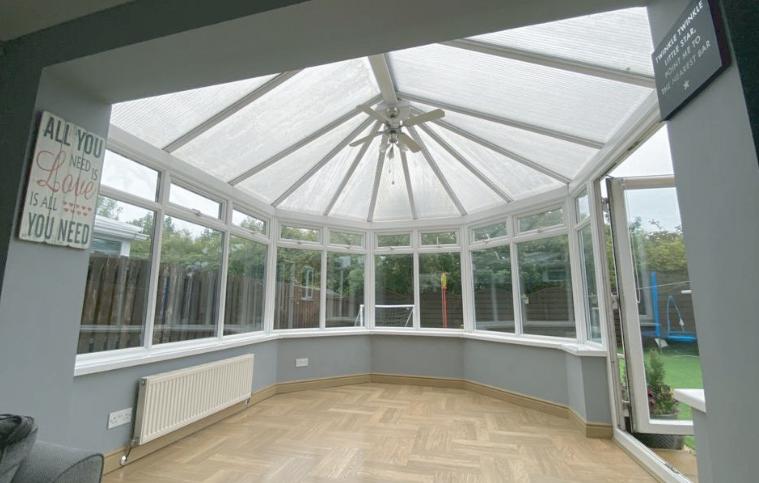
• Cost-effective alternative to a solid tiled roof
• Choice of PVC or plastered finishes
• FREE survey
• FREE written quotation
• 10 Year guarantee
www.sagars365.com
vertical blinds to roller blinds and from Roman to Venetian, vision blinds and pleated.
Take an honest re-appraisal of the OUTSIDE of your house and see if that smart exterior you originally bought into is long gone and might need a fresh coat of paint or new fascia boards.
Is it still the welcoming place you remember or does your FRONT DOOR need painting or replacing with something more modern and brighter?
A front door that allows in plenty of light can transform a HALL so it’s well worth the investment and taking a look around local suppliers. And while we’re in the hall, does it give a positive first impression of who you are?
JUST when you’re looking around your home and considering moving or drastic renovation a visitor praises your property and forces you to re-consider your views.
Every now and then, it’s a good idea to re-appreciate your home and remember just what attracted you to it in the first place. This may have been its location, its sunny outlook, airy rooms, its living flowthrough or simply its potential.
It’s good to recall what drew you to it and remember those feelings.
It also helps that re-appreciation to take a quick sensory tour of your home and recall the pleasures – your cosy couch, the warmth of the sun coming through your lounge windows or the feel of a fluffy rug under your feet.
Have you got lovely neighbours? Is the area pleasant and convenient for your lifestyle, your work and your social life? Can you live in that property comfortably within your means?
If you listen to your visitors’ opinions, you may well see your home through a fresh pair of eyes and be pleasantly surprised.
However, if you find that you’re still not 100 per cent happy with where you are, consider using all those pluses you’ve re-recognised and improving them.
Those lovely WINDOWS that let in the light so well may need enhancing or even changing, perhaps to double-glazed windows that help keep insulation costs down.
Or, you may need to re-think the current curtains. Are they too dark and don’t enhance the sunny rays that light up your room? New curtains don’t have to cost a fortune and opting for full-length ones can make your room look much larger.

Blinds today come in all kinds of styles and patterns so pop along to your local store or go online to see how they can enhance any window. You’ll be amazed at the latest styles – everything from
If not, it may be that you need to declutter it – move all those coats and shoes into a cupboard or shoe-racks, decorate in bright colours and add a large mirror to reflect light and give an illusion of space if it needs it.
A change of FLOORING can make a huge difference to any area of the house but especially in the popular areas like the lounge and kitchen where family members tend to gather.

Whether it’s carpet, wood, eco-friendly bamboo or tiles, new or different flooring can make you take that fresh look at your home and learn to re-love it.
Wooden flooring with attractive rugs can be particularly effective in a lounge, especially with a log-burning fire or open fireplace. The glow just seems to start there and emanate around the room so if you always liked the cosiness of your lounge, here’s a chance to enjoy it once more.
As we go into the chillier months, it’s worth ensuring your CENTRAL HEATING is working properly. You can’t re-appreciate your home if you’re shivering!
Do you need a new boiler? Bring in a qualified Gas Safe engineer near you - to find them go to https://www.gassaferegister. co.uk/ or try British Gas at https://www.britishgas.co.uk/homeservices/boilers-and-heating/guides/trusted-gas-engineer.html
Check on DRAUGHTS in your home for the same reason and take a special look around doors and windows. This is going to be a particularly energy-conscious Winter and draught-proofing is one of the cheapest and most effective ways to save energy and save money.
Uncontrolled draughts just blow money out of the door or window. The Energy Saving Trust states you could probably save around £45 a year by draught-proofing doors and windows and, if you have an open chimney, when you’re not using it draughtproofing could save around £65 a year.
Just remember that your property still needs ventilation with air flowing in and out of your home to stay fresh, dry and healthy. So make sure you don’t block or seal any intentional ventilation like extractor fans, underfloor grilles or airbricks, wall vents or trickle vents on modern windows.
A change of relaxing colour scheme here can also soon make you re-appreciate this important room. Even something much cheaper like changing the colour of the bedding and curtains can make a dramatic difference.
When thinking of a new BATHROOM. The same idea of changing accessories can help you re-like your bathroom. Change the shower curtain and add matching bathroom accessories or bring in plants in matching pots.
If you are improving your home, it’s worth keeping in mind as a homeowner that you might be able to get help towards interest payments on your mortgage and/or loans you’ve taken out for certain repairs and improvements.
It’s worth considering accessibility. A walk-in bath is the perfect solution for when stepping over the side of a conventional bath becomes more challenging and dangerous.You can still retain the traditional lying down.
KITCHENS can look outdated and unloved but you don’t have to make a big investment to change your mind on yours. New doors or worktops can make a real difference and just changing the colour scheme and adding updated modern taps, for example, can make you love it again.

The same is true of BEDROOMS where units may just need updating. Call in a local bedroom furniture supplier that has either done work for someone you know who can recommend them or has positive reviews posted online.

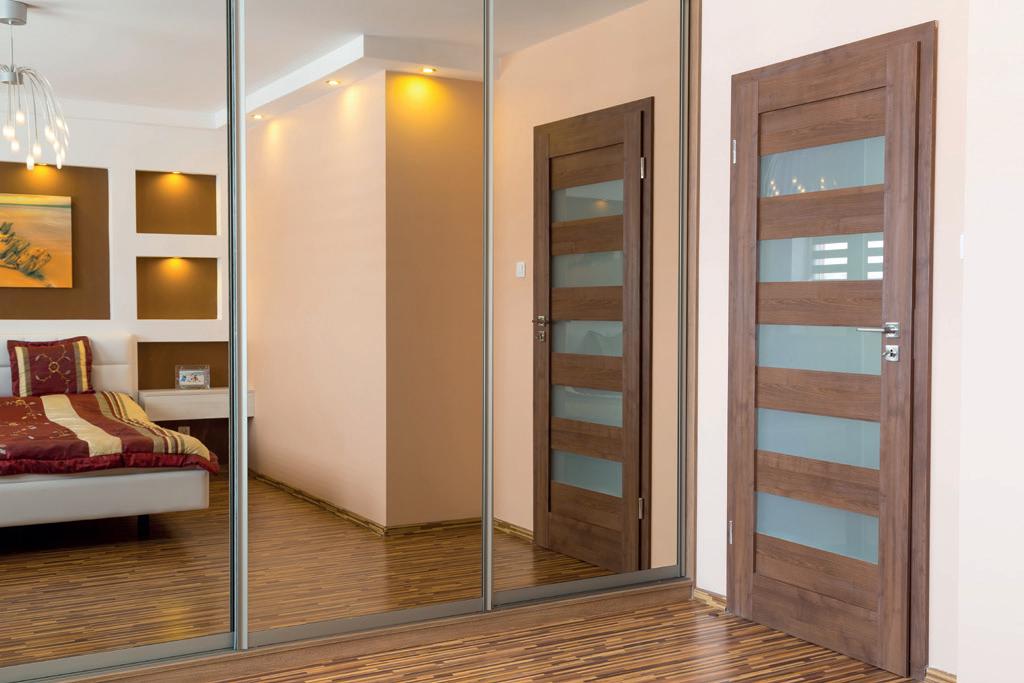
WET ROOMS are not only the latest and most convenient way of washing, but they are also the most accessible style of bathroom. Ideal for individuals with limited mobility and those that require wheelchair access.

EA Mobility wet rooms provide the perfect solution for those clients looking to fully future proof and ensure their bathrooms are suitable for whatever unforeseen changes occur with regards to mobility needs and requirements.
You do not need to step over a tray when getting in or out of a wet room as they are on the same level as the bathroom floor and with our stylish range of anti-slip safety flooring options, shower panelling or wall tiling you don’t have to compromise on the design and aesthetics of the bathroom.
Re-appreciating your home just takes a willingness to look at it differently - and be honest about what you always loved about it and can do again.








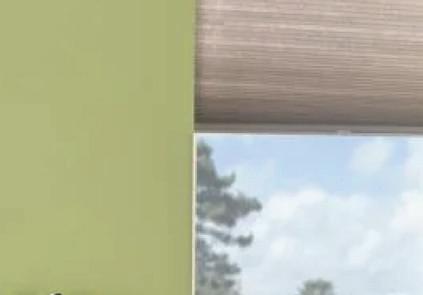
























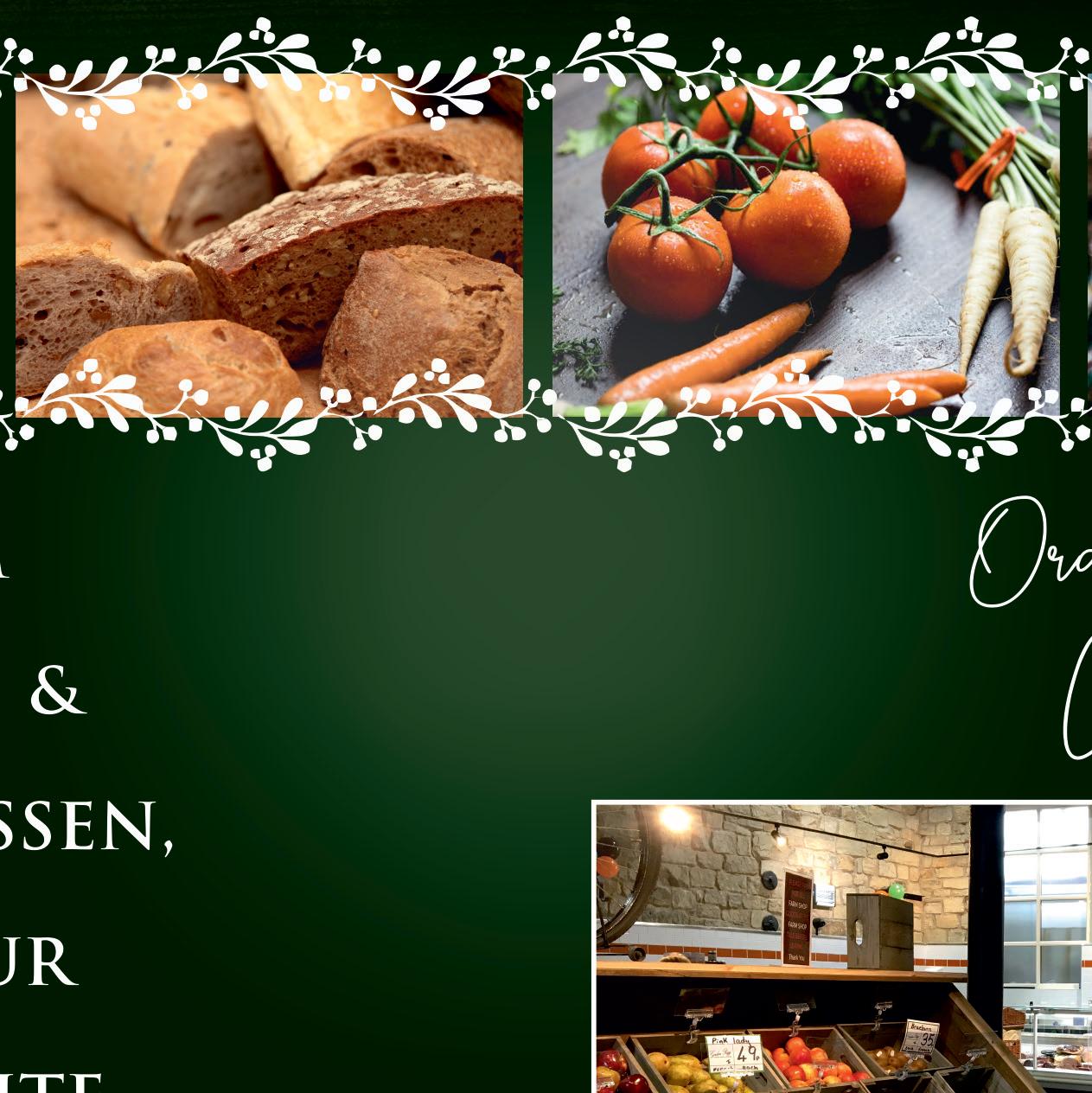
















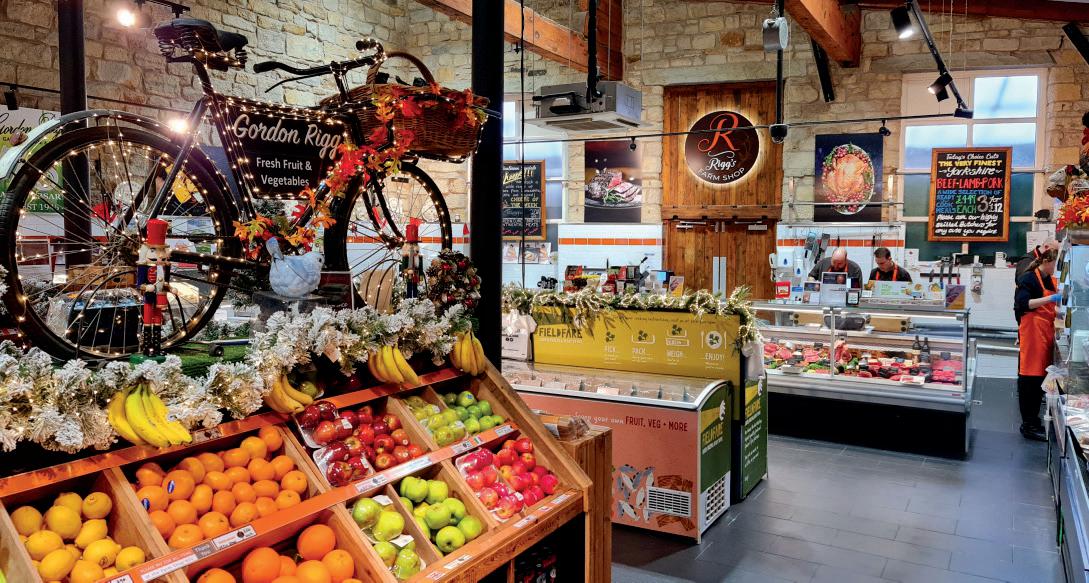

big blooms upright. Plant the bulbs no later than the beginning of November and keep the soil moist, but not drenched. When flowering, the bright red blooms will enjoy a semi-cool, humid spot in the home with bright, indirect light and plenty of moisture. In spring, return the plant to a sunny area and water well.
Poinsettias are a pretty, bright plant that is widely grown indoors over Christmas for their beautiful, red bracts. They should only be watered once the compost has begun to dry out. Overwatering poinsettias can really damage the plant, instead, regularly misting the plant with a spray bottle is beneficial, especially when flowering.
Brits are being offered advice on the easiest festive house plants to care for this Christmas.
Experts at GardeningExpress.co.uk have investigated the low maintenance plants to make the perfect Christmas centrepiece.
They’ve looked at varieties including traditional festive foliage choices like poinsettia, holly, and rosemary, all the way to unusual blooms like the Christmas cactus, desert roses and African violets.
Festive families looking to take an organic approach to their Christmas decorations can also take inspiration and deck their halls with pretty plants.
With growing concerns about plastic use, they’re much more eco-friendly options and are reusable year after year with the right care.
Chris Bonnett from GardeningExpress.co.uk said: “There are some fantastically festive plants and flowers which are easy to care for during the chillier months and will add the spirit of Christmas to any room.

“Many of these blooms also make for beautiful presents, so are worth bearing in mind when buying for green-fingered friends or family members.”
“Whilst these varieties are easy to care for, they can be pretty picky with heat and light. A windowsill might seem like a good idea, but the temperature really fluctuates in front of the glass in the winter, especially if there’s a radiator underneath,
“Avoid draughts and hot spots near radiators or fires too. Instead, display them somewhere that’s bright yet maintains a steady temperature.”
GardeningExpress.co.uk’s seven festive plants that are easy to care for:
The massive, six-pointed amaryllis bloom makes an impressive festive decoration and a support stake will be handy for keeping

The Christmas cactus is nothing to do with either the Christmas tradition or the story of Christ’s birth, but they are easy to maintain during cooler months. They look amazing too, flowering from late November all the way to late January. They will live happily in humid environments like kitchens and bathrooms, as they grow in tropical rainforests in the wild. During the summer months, when the risk of frost has gone, they can be placed outside. This will help to ripen new growth and encourages flowering. Keep them in a shady spot and protect them from slugs
Rosemary is the most authentic Christmas plant about, as it’s thought to be one of the plants in the manger where baby Jesus was cradled.

The plant is an attractive evergreen shrub with needlelike leaves, and it is super easy to care for. Provide the herb with well-drained, sandy soil and a solid amount of sunlight. These plants thrive in warm, humid environments and should be moved into a cosy spot in the home over the winter months.

These strong plants are native to regions with warm climates, so should be kept out of the cold at all costs. When kept as a house plant, they are the perfect specimens for nervous or novice gardeners. A fat trunk is an indicator of health on this plant, whereas a skinny stem is the plant screaming that it needs watering.
Whilst these aren’t the easiest plant to look after, they are blooming gorgeous. They take up a small amount of space in the
home and can make a delightful display when a few are bunched together. African violet plants should be watered when the soil doesn’t feel moist with lukewarm or tepid water which has been left to stand for 48 hours. These fussy flowers will be well worth the beautiful blooms that come during colder climates.

This Christmas classic is a symbol of eternal life and fertility. Back in the day, people believed that hanging the plant in homes would bring good luck and protection. When grown in the home, holly will thrive in moist soil positioned in slight suntraps. However, they aren’t just limited to December along with the decorations, they make a lovely year-round houseplant.

With the height of winter approaching, gardeners are being offered the best ways to protect plants over the chilly months.
The experts at GardeningExpress.co.uk have pulled together the best ways to make sure your plants survive the drop in temperature and shorter days.
Tips include insulating plant pots with bubble wrap, making mulch and recycling old bottles to save the plants and some pennies.
Preventative measures, like sheltering plants, clearing up spaces and insulating soils work great, but sometimes extra steps need to be taken to keep plants healthy.

Chris Bonnett from GardeningExpress. co.uk said: “Over summer, gardens provide a sanctuary away from the business of life, but over winter they start to look dilapidated.
“The youngest plants in the garden are most likely to be affected by harsh weather. However, even the hardiest varieties sometimes become damaged over a long cold spell.

“If you spot damage to any plant, it is best to remove it straight away to stop it spreading elsewhere. Look at any winter upset as an opportunity to improve your garden skills and make your plants stronger as a result.”
GardeningExpress.co.uk’s tips to protecting plants this winter
Gently covering delicate plants with bubble wrap can insulate the plant and keep it protected against some harsher weather. Covering the top of the soil with a wrap is a good idea too, as it will protect it from going through frequent periods of freezing and thawing. Get ahead of the game and start potting next year’s plants in bubble wrap lined pots in anticipation of the next chill.
Plants often rely on leaning against structures, like sheds, fences, and walls to grow to their full potential. Make sure that these structures are strong enough to make it through the windy, rainy, and cold winter. Plants trained against walls can be protected from the cold with fleece-covered frames.
Before any turbulent weather, it is a good idea to streamline plants by removing any dead shoots. This will also reduce the risk of any long limbs or branches snapping and tangling.
When ice or frost is forecast, take the more sensitive plants and offer them some shelter. Somewhere unheated is best. Plants will hate being brought inside the home, as it will be too hot, but consider clearing out space in the shed or garage for them to live.
Individual plants can also be protected using homemade “mini cloches” made from plastic drinks bottles. To create this type of cloche, simply cut the top and bottom of the bottom before placing it around the plant. This method should protect delicate leaves on young plants from chilly temperatures. You should try to remove these cloches each morning to ensure the air inside does not overheat and damage the plant.
Mulch can be made using organic matter like decaying leaves, bark, straw, or compost. Placing it around the roots of plants will help insulate and protect them from the cold, however, it only tends to work with hardier plants.
Winter throws lots of challenges at gardeners and no matter how well looked after your plants are, there is still a small risk of them dying. It’s a great idea to keep the plant tags that comes with nonperennial plants or take a cutting from perennials that are a worry.
Theo Randall’s passion for food was born from regular family holidays across Europe and from a young age he was destined for a culinary future. His career began as a waiter at London’s acclaimed Chez Max and after only a few weeks, Max Magarian noted Theo’s talents and invited him to work in the kitchen where he spent the next four years following an apprenticeship in classic French cuisine. In 1989, Theo joined the up-and-coming River Café and quickly found his culinary home with the legendary Ruth Rogers and Rose Gray MBE. After a year’s secondment cooking alongside Alice Waters at Chez Panisse in Berkeley, California, Theo returned to The River Café and brought inspiration from the bountiful Californian produce he had been working with. Theo then remained at River Café for a further 15 years as head chef and it was under his patronage that the restaurant received its first Michelin star in 1997. He left to launch Theo Randall at the InterContinental, which opened in November 2006. His commitment to delivering rustic produce-driven Italian food from the prestigious address of No. 1 Park Lane has earned him loyal followers and rave reviews from critics and food-lovers. While he is a regular on national television, including BBC One’s, Saturday Kitchen, Theo remains true to his culinary roots and can be found at the restaurant most services. He has published three successful recipe books: PASTA (2006), My Simple Italian (2015) and The Italian Deli Cookbook (2021), and his latest book, The Italian Pantry, released on 1 September 2022.

This recipe is a perfect midweek dinner; easy to prep and comforting to eat. There are lots of really good, dried egg tagliatelle pastas on the market – I always go for the brands Rumo or Giovanni Cocco. Or, of course, you could always make fresh pasta.
Serves 2–3
• 100g (3½oz) pancetta, cut into matchsticks
• 75g (2½oz) pine nuts
• 250g (9oz) chestnut mushrooms, thinly sliced
• 1 garlic clove, finely sliced
• 1 teaspoon thyme leaves
• juice of ½ lemon
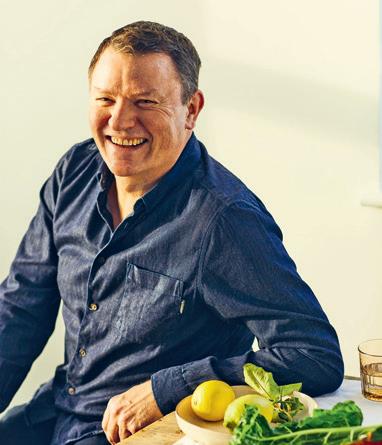
• 100g (3½oz) mascarpone
• 250g (9oz) dried tagliatelle
• 1 tablespoon chopped flat-leaf parsley leaves
• 75g (2½oz) parmesan, grated, to serve
• sea salt and freshly ground black pepper
Heat a large, heavy-based saucepan over a medium heat. When hot, add the pancetta to the dry pan and leave it to cook for a few minutes, until the fat has rendered and the pancetta is crispy. Add the pine nuts and cook for about 1 minute, until they are a light golden colour. Remove the pancetta and pine nuts from the pan with a slotted spoon and set them aside to drain on kitchen paper. Leave the fat in the pan. Add the mushrooms to the pan over a medium heat. Fry until the mushrooms have released their liquid and become syrupy, then add the garlic and thyme and fry for 2 minutes more. Add the lemon juice and
season with salt and pepper. Reduce the heat down to low and stir in the mascarpone. Bring a large saucepan of salted water to a boil. Add the tagliatelle and cook for 2 minutes less than the packet suggests, then, using tongs, transfer the pasta to the pan with the mascarpone mixture. Add a ladleful of the pasta cooking water and stir through the parsley. Mix everything together with a wooden spoon and cook for 1 minute, adding another ladleful of pasta cooking water if the tagliatelle feels a little dry. Toss the pasta so it is juicy and coated in the sauce. Serve the tagliatelle in warm bowls with the crispy pancetta, pine nuts and a little extra parmesan sprinkled on top.

This dish was on the menu at Theo’s Simple Italian in Kensington – sadly, the restaurant is no longer, but the dish is still very much a classic. The richness of the meatballs with the vibrant tomato sauce is very comforting and it’s a perfect dish to serve to a large gathering. I love the addition of the chopped burrata, as it makes the tomato sauce taste even sweeter and adds a soft, creamy texture. Scale the quantities up or down as required.
Place all ingredients for the meatballs into a large bowl and combine to form a firm, evenly distributed mixture. Cover your hands in olive oil, take a generous tablespoon of the mixture and roll it between your palms to form a meatball the size of a golf ball. Repeat until you have used all the mixture – you should have 16 meatballs. Place them on a tray in the fridge to firm up for 30 minutes.
Place a large, non-stick, ovenproof frying pan over a high heat and add a tablespoon or so of olive oil. When the oil is hot, begin browning the meatballs (in batches if necessary), ensuring you don’t cook them completely – a little colour on the outside is perfect. Once they are all browned off, remove them from the pan and leave them to one side while you make your tomato sauce. Preheat the oven to 200°C/180°C fan/400°F/Gas 6. Make the tomato sauce. Add 1 tablespoon of the olive oil to the pan and set it back over a medium heat. When hot, add the garlic, thyme and chilli. Simmer for 1 minute, then add the passata. Cook gently for 15 minutes, or until the sauce has reduced by half. Season the sauce and take the pan off the heat.
Place the meatballs in the pan on top of the sauce, evenly spaced, then transfer the pan to the oven and bake for 20 minutes, until the meatballs are cooked through. Leave to one side for 5 minutes to cool slightly (leave the oven on). Drizzle a little oil over your ciabatta slices and sprinkle them with some sea salt. Place them on a baking sheet and bake them for 4 minutes, or until crispy, then rub them all over with the garlic clove. Meanwhile, finely chop the burrata, then use a spoon to drop dollops all over the baked meatballs. Give everything a sprinkle of sea salt and a good grinding of black pepper, then serve in the middle of the table alongside the crostini and let everyone help themselves.
• 1 ciabatta or sourdough loaf, cut into thin slices
• 1 garlic clove, to rub
• 1 x 150g (5½oz) burrata sea salt and freshly ground black pepper
For the meatballs
• 400g (14oz) pork mince (ground pork)
• 400g (14oz) beef mince (ground beef)
• 2 tablespoons chopped flat-leaf parsley leaves
• 1 garlic clove, crushed to a paste with a little sea salt
• 3 tablespoons whole milk
• 100g (3½oz) dried breadcrumbs
• 75g (2½oz) parmesan, finely grated
• 3 eggs
• 1 teaspoon sea salt
• 2 tablespoons extra-virgin olive oil
For the tomato sauce
• 2 tablespoons extra-virgin olive oil
• 1 garlic clove, finely sliced
• 1 teaspoon chopped thyme (not lemon thyme)
• 1 red chilli, deseeded and finely chopped
• 600g (1lb 5 oz) tomato passata

• 4 tablespoons extra-virgin olive oil
• 2 red onions, finely sliced
• 500g (1lb 2oz) courgettes (zucchini), cut into 1cm (½in) rounds
• 1 garlic clove, finely sliced
• 500g (1lb 2oz) tomato passata
• 8 basil leaves, roughly torn
• 3 aubergines (eggplants), sliced into 2cm (¾in) rounds
• 300g (10½oz) egg-based dried lasagne
• sea salt and freshly ground black pepper
• 75g (2½oz) unsalted butter
• 75g (2½oz) plain (all-purpose) flour
• 500ml (17fl oz) whole milk, warmed to just below boiling point
• 150g (5½oz) parmesan, grated, plus extra for sprinkling
My mother used to make the most delicious lasagne – I used to get so excited when I knew it was coming. She was brilliant at making the béchamel sauce – it was always perfectly creamy but never thick and floury. The trick to this was to cook it very slowly and use equal quantities of flour and butter. This is a vegetable lasagne, but it has as much flavour as the traditional meaty offering because you roast the aubergines (eggplant) first. Try to use egg-based lasagne sheets as they tend to have more flavour and are not as brittle when you cook them (or, better still, make your own sheets of pasta).
Preheat the oven to 200°C/180°C fan/400°F/Gas 6. Heat 1 tablespoon of the olive oil in a non-stick frying pan over a medium heat. Once hot, add the onions, courgettes (zucchini) and a good seasoning of salt. Cook for 20 minutes, until the onion and courgettes are soft. Heat another tablespoon of the olive oil in a separate saucepan, then add the garlic. Fry the garlic for 30 seconds, then add the passata and cook the mixture gently for 20 minutes, until reduced by half. Season with salt and pepper, then stir through the basil.
Brush both sides of the aubergine (eggplant) slices with olive oil and season them with salt. Place the aubergines in an even layer on a baking sheet lined with baking paper. Bake them for 15 minutes, then turn them over and bake them for a further 15 minutes. Remove the slices from the oven and, when they are cool enough to handle, cut them into halfmoons. Set them aside and leave the oven on.
To make the béchamel, melt the butter in a medium saucepan over a low heat. When the butter has melted, add the flour and cook it out for a couple of minutes, stirring to combine. Next, add the hot milk and stir continuously to avoid any lumps forming. Cook the sauce gently for 20 minutes, stirring all the while, until smooth and thickened, then mix in the parmesan and check the seasoning. Leave to one side.
Mix the aubergines, courgettes, onions and tomato sauce together in a large bowl and check that everything is seasoned well. Use the remaining olive oil to oil a baking dish, then place a layer of lasagne sheets in the base of the dish. Add one-third of the vegetable mixture in an even layer, then top this with one-quarter of the béchamel sauce. Repeat this twice more, then finish with a layer of lasagne sheets and a final layer of béchamel sauce. Sprinkle the top with some more parmesan, then bake the lasagne for 35 minutes, until the pasta is cooked and the top is golden. Serve with a little extra grated parmesan on top, if you like.
This has to be one of the easiest and tastiest cheesecakes around. Ricotta is used in place of cream cheese, making for a much lighter mouthful, however this means that it’s important to allow enough time for the cheesecake to set fully – ideally you’d make it a day in advance. The best ricotta to use for this is sheep’s milk ricotta, but you will only find this in Italian delis or in a farm shop that sells local cheese.

Despite being within Sheffield's border, the Strines Inn could be a world away. Nestled amongst breathtaking moorland scenery, it is one of the local landmarks in the Peak District National Park.

• 200g (7oz) cantuccini biscuits
• 75g (2¾oz) unsalted butter
• 50g (2oz) light brown soft sugar
• 500g (1lb 2oz) ricotta, drained
• 100g (3½oz) mascarpone
• zest and juice of 2 Amalfi lemons
• 125g (4½oz) icing sugar, sifted
Tip the cantuccini into a food processor and blitz them to a fine crumb. Alternatively, place them in a Ziplock bag and bash them with a rolling pin or saucepan. Set aside. Melt the butter in a medium saucepan over a low heat, then add the blitzed cantuccini biscuits and the sugar. Cook, stirring, for 1 minute, then take the pan off the heat. Tip the mixture into a 22cm (8½in) non-stick springform cake tin, pressing the buttery crumbled biscuits over the base to create a biscuit base. Transfer the tin to the fridge while you make the ricotta filling. Using a hand-held electric whisk or a wooden spoon, beat together the ricotta, mascarpone, lemon zest and juice and icing (confectioner’s) sugar in a large mixing bowl for 4 minutes, until the mixture is creamy and light. Spoon the ricotta mixture into the springform tin and spread it out into an even layer over the base. Refrigerate to set for a minimum of 3 hours, but preferably overnight, before releasing the cheesecake from the tin. Transfer it to a serving plate and top with extra lemon zest before slicing.
The Italian Pantry by Theo Randall (Quadrille, £26). Photography: Lizzie Mayson.
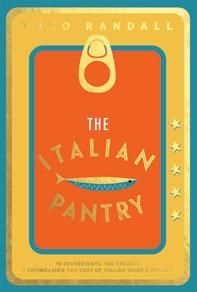

Originally a manor house, it was built in 1275 for the Worrall family, although most of the present day structure is 16th Century. After becoming an Inn in 1771 when John Morton leased the property from the Worrall's, it got its name from an Olde English word meaning the meeting of water, quite appropriate as nowadays it overlooks the Strines Reservoir.
In the height of Summer the Inn attracts hundreds of visitors on a daily basis. The glorious sunshine and stunning views perfectly compliment the excellent food and drink available, with many dishes being homemade.

The Strines Inn is also famous for its numerous peacocks, the previous Landlord having introduced several pairs twenty years ago, there are now over thirty of them.
There is also accommodation available for those people looking to escape for a few days to relax. Our rooms all feature four-poster beds, en-suite bathrooms, hot drinks facilities and colour televisions. Each has a dining table where breakfast will be served to you, offering you comfort and privacy. Two of our rooms have fantastic views across the reservoir, so please ask if you would like a room with a view.
Four-poster bed
En-suite facilities
Breakfast included
Cocktails should be simple. Acclaimed drinks writer Alice Lascelles knows everything there is to know about making delicious drinks at home with minimal equipment and fuss.


The Cocktail Edit is built around a ‘capsule collection’ of 12 classic cocktails – each of these is followed by six twists, plus tips and inspiration for creating many more. The book also offers essential advice on getting your home bar set up – and shows how easy it is to make amazing cocktails with just a few basic tools, ingredients and techniques.
If you only commit one recipe to memory, make it the 4:2:1 sour –because four parts strong, two parts sour, one part sweet recurs time and again in the cocktail canon. It’s the formula for the Daiquiri, the Whiskey Sour, the Bramble and the Basil Smash, and the backbone of the Mojito, Collins and French 75. With a bit of a tweak to allow for less sweet liqueurs, it also informs the Aviation and the Margarita. Pick apart many punches, and you’ll find a 4:2:1 sour at their core. Once you know it, you’ll spot it everywhere in a multitude of forms.
Ingredients
50ml gin
25ml lemon juice
• 12.5ml sugar syrup
• GLASS: cocktail glass
• GARNISH: lemon or orange twist
You can make a 4:2:1 sour out of any white spirit. But it’s the Gin Sour that I find the most useful; it’s key to so many classics and can be adapted in many ways.
You can lengthen it with sparkling wine or soda or jasmine tea to make a refreshing punch. Or sweeten it with a homemade flavoured syrup, instead of plain syrup, or maraschino or triple sec (if you’re using liqueurs instead of 2:1 sugar syrup, just add an extra teaspoon or two).
You can shake it with cucumber, or basil, or lavender or mint. Or serve it over ice and drizzle it with blackberry liqueur or Campari. You can spike it with orange bitters or scent it with a spritz of absinthe. It’s happy on the rocks, in a coupe, or blitzed with ice in a blender. It can be shaken or mixed in a jug. If you take away the alcohol and add water – hey presto, you’ve got lemonade. And if you don’t have lemons, no matter – it works equally well with lime.
Once you know the 4:2:1 formula, you can busk a drink out of just about anything: the dregs of a party, corner-shop booze or the finest gin and lemons from Amalfi. Consider it your cocktail survival kit.
Ingredients
50ml bourbon/rye whiskey
5ml sugar syrup
1 dash bitters
GLASS: rocks
GARNISH: lemon or orange twist
METHOD: stir with ice
The Cocktail Edit by Alice Lascelles (Quadrille, £16.99).
Photography: Laura Edwards.
For the Nectarine syrup:
• 50ml vodka or gin
• 150ml tomato juice
• 15ml dry sherry
• 2 dashes Worcestershire sauce
• 3 dashes Tabasco
• 1 grind pepper
• 2 pinches celery salt
• 10ml lemon juice
GLASS: rocks/small juice glass
GARNISH: any combination of celery stick, lemon slice and spicy salt and pepper rim
The perfect Bloody Mary recipe is highly subjective. But I think it’s much improved by the addition of sherry and celery salt – two ingredients that really amplify the umami. I’m also not averse to using a good-quality spiced tomato juice if one is available. Shaking a Bloody Mary, or serving it over ice, can turn it thin and watery – it’s better to stir with ice and strain, or serve chilled, straight from the fridge. You could also rim the glass with a mix of salt, pepper and spicy shichimi for extra firepower.
Despite what the name might suggest, the Old Fashioned was not the world’s first cocktail – drinks like the Sazerac got there several decades before. But of all the bittered whiskey cocktails to emerge from America in the 1800s, it remains the best known and the most widely adored.
Part of its charm is its lack of pretentiousness – it can be made any time, any place, anywhere. It doesn’t require fancy tools or, save the twist, fresh ingredients. It’s an end-of-days kind of a drink.

The earliest Old Fashioneds were almost certainly made with rye whiskey. Sweet, nutty and spicy, rye gives the drink an almost tactile quality. I love Sazerac Rye and Rittenhouse with its notes of leather and cherrywood smoke. Bourbon gives you a drink that’s a bit more mellow and rounded – Buffalo Trace, Woodford Reserve or the smooth-sipping wheated bourbon Maker’s Mark would all be good.
A good selection of cocktail bitters will increase the mileage you can get out of this drink. Anything spicy, citrusy, nutty or chocolatey is almost certain to work.
At the height of its popularity, in the 1880s, the Old Fashioned wasn’t just one drink, it was a whole genre: Americans drank Old Fashioneds made with rye, sweet gin, genever and imported French brandy. And that spirit-sugar-bitters formula can be adapted to suit all kinds of hard liquor. Over the page, you’ll find a delicious Old Fashioned made with rum.
The Old Fashioned has a reputation for taking ages to make – a hangover, perhaps, from the days when it was sweetened with loaf sugar and required masses of stirring. If you use sugar syrup, however, it’s the work of a moment. Either way, its enjoyment should not be rushed.

WHEN
caravan, campervan or motorhome – especially if you are a first-time buyer of such a vehicle – the prospect may seem daunting, perhaps even a little overwhelming. How do you know where to look, what features to consider and how to choose the right unit for your needs?


If

specific tips on buying your first van, Rob Debenham, Show Manager of The Caravan, Motorhome & Holiday Show, is here to give his
on some of the most important things to look for as a first-time buyer to make sure that you and your vehicle have the best adventures possible.
Before you part with any money, think about why you want this vehicle and what you will be using it for. Do you plan to embark on a new adventure, travelling across the country (or world) in your new home? Or will it be for long weekend excursions and summer staycations? What you want the van for and how you plan to use it, will play a big role in your final decision of vehicle choice.
A good starting point is speaking to fellow caravan and motorhome owners. Use this as an opportunity to ask questions about the caravan, campervan or motorhome they own. Why do they like it? What would they recommend and why? What is something they wish they knew before they purchased it? These conversations will help you ensure you’ve made the right decision when it comes to choosing your van.
Attending a show such as The Caravan, Motorhome & Holiday Show, or similar is another great way of helping your decision-making. They are fantastic one-stop shops that allow you to see a wide variety of vehicles under one roof, get up loose, explore inside and familiarise yourself with them.You’ll also get to speak to expert dealers and manufacturers so you can ask all the questions you need about specific vehicles.
Once you know what van you want and how you want to use it, regardless of whether you plan to live in your van or just want to use it for the occasional adventure, there are some necessities when it comes to what you will need to buy or install for your vehicle.
You may want to make getting a fixed bed, for example, a priority. The alternative would be converting your table into a bed and vice versa or sleeping above the seats in the cab.
Another handy feature your van may benefit from is a solar panel on the roof. By installing a solar panel, you can easily top up your leisure battery and lessen the worry that you will run it down, especially when you are going off-grid. A leisure battery is a power source that can fuel the 12V appliances and equipment in a caravan or motorhome. These batteries are designed to provide a steady level of power over a prolonged period of time and are used for the lights, television, kettle, oven and similar appliances in your van.
Unless you plan to undergo your van adventures with no electric appliances, you will probably be picking up a leisure battery during the purchase process. When you do, you may feel as though there is so many choices that you feel overwhelmed. But as with everything in this process, try making sure you thoroughly research and choose a trusted and high-quality brand. Depending on your use, you may also want to think about having multiple leisure batteries.
And finally, the last suggestion of what can be installed in your van to make life just that little bit easier is a refillable gas bottle – this will be sure to save you a lot of money in the long run. Many vans do come with the capability already installed, so it’s worth looking into when browsing models.
Remember, getting any kind of van – a caravan, campervan or motorhome – should be an exciting prospect. This is the starting point of the many thrilling adventures still to come, and though it may initially feel daunting, these feelings of fear can always be quelled by extensive research on your behalf so you can be sure you are doing everything possible to make the best purchase for you.



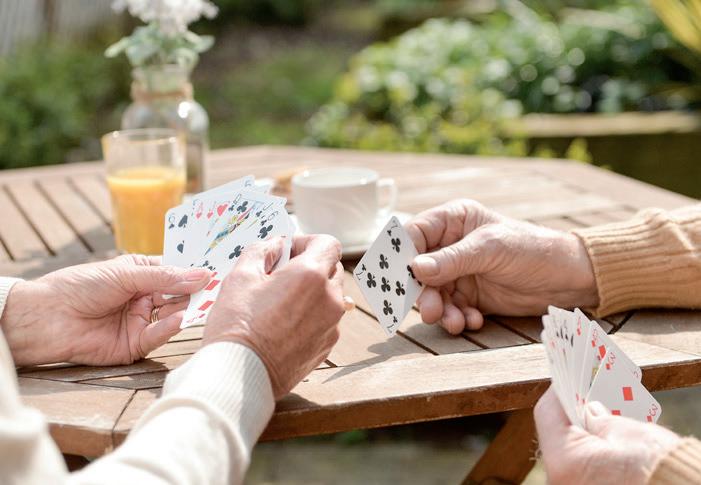
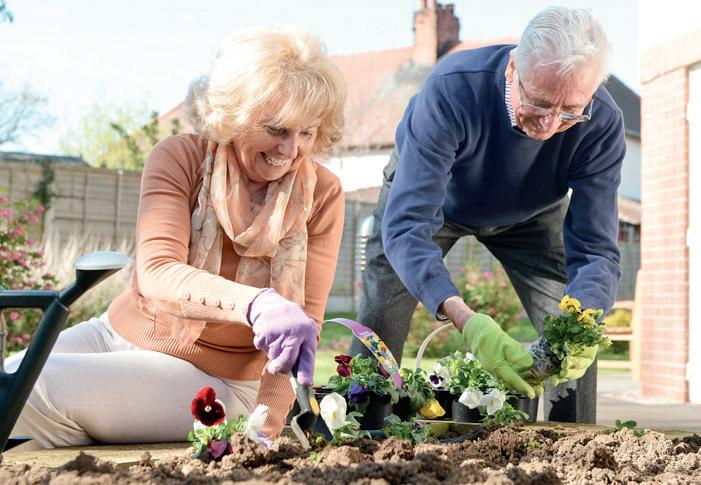

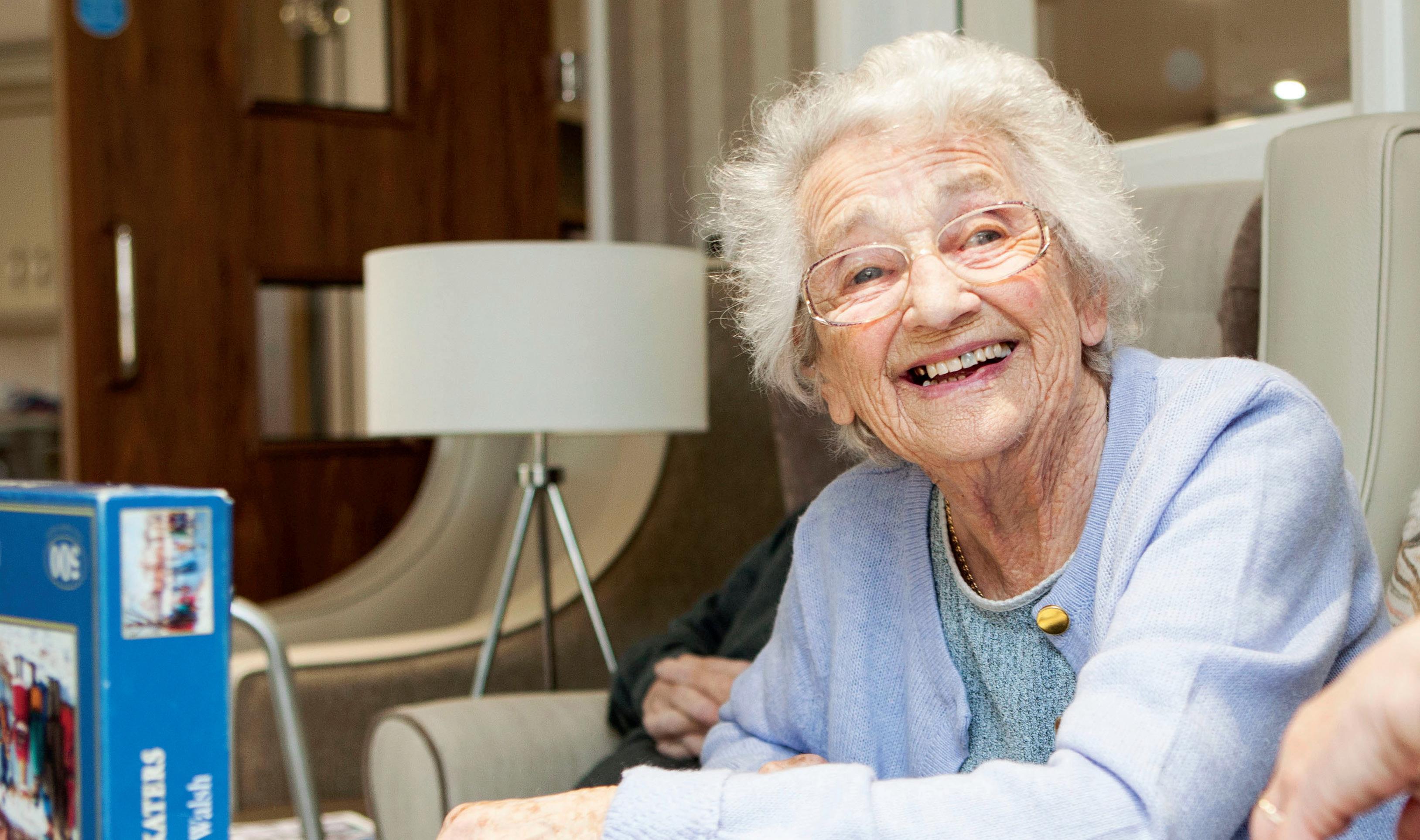

Dedicate a light to someone you love this December and join us to celebrate their life.
Each year, as the festive period approaches, Light up a Life brings us together to celebrate the lives of those we love most and light the tree in the heart of The Kirkwood gardens in their memory.

When you make a dedication to someone special as part of our Light up a Life appeal, we’ll send you a special card bearing your loved one’s name. We’ll also invite you to join us at one of our Light up a Life events in December so you can see visit our gardens as they shine brightly in honour of your loved one
Make your dedication today at: thekirkwood.org.uk/lightupalife or call us on:



Have you discovered The Kirkwood’s fantastic Christmas Card and gift collection yet? Our bespoke cards are perfect for sharing that special greeting with those you love this festive season. We also have a range of fabulous seasonal gifts – perfect for that last minute stocking filler.
From our 2023 calendar and pocket diaries, to soft furnishing and even jewellery, you’re sure to find something you love in one of our shops or at our online store.


And even better, 100% of the profits from sales of our Christmas cards and gifts go straight back to the charity, helping us to provide the very best care for families affected by any life limiting illness in Kirklees.

Our exclusive collection of Christmas cards and festive gifts is available now in all The Kirkwood Shops and online at: shop.thekirkwood.org.uk


Thinking about full time care? Chances are you want to live in your own home for as long as possible. But what if illness, dementia or Parkinson’s makes this seemingly impossible? A care home may seem like the only option.
With live-in care you can stay in your own home with the support of a care worker who lives with you. This means 24-hour support, seven days a week.
Whether you need support with personal care, medication, household tasks or just a bit of companionship, a live-in care worker can help. But why is live-in care growing in popularity worldwide? And why is it the ideal way to avoid moving into a care home?
For one thing, it’s all about companionship. You don’t have to worry about being at home alone. No. Instead, you have consistent support from a friendly face who will help you live life the way you want to.
This is completely different to what you can expect from other care options. No rota of care workers. No unwanted periods of isolation. Just a single companion to provide physical and emotional support, whenever it’s needed.
Live-in care takes the ‘tired’ out of ‘retired’. It means you can continue to be independent and get back to doing the things you love. Like shopping and days out.
Maybe you want to pick up an old hobby, or visit friends and family. Whatever it is, there’s no pre-set schedule, no pre-planned activities. Just consistent support to help you enjoy whatever you wish to do.
We all like to imagine growing old in a home of our own. Well, live-in care makes that a reality. Since the care worker comes to live with you, there is no change to routine, no stressful move and no loss of independence.
In a care home, you can only take a few treasured possessions; with live-in care everything remains just as it should be. Your favourite chair stays in the perfect spot in front of the TV; family photos remain hung up on the wall. In fact, the only real change is the peace of mind you feel, knowing that support is there when you need it.
Finding the right care is difficult for the whole family. Especially if your loved ones have become your primary caregiver. The right care option can take away their stress and anxiety.
Live-in care gives peace of mind to the whole family. Your family won’t need to worry about you being isolated at home. And can rest assured that, should anything happen, professional care is there.
Agincare is a family-owned organisation trusted by families for over 35 years. We are experienced in supporting people with a range of needs and are fully regulated by the CQC.
If you are worried about your care options. If a care home seems like the only option. Speak to one of our advisors about live-in care today.
Get back to enjoying life with 24-hour live-in care at home.
A care worker will come and live with you, providing care, help with household tasks, and companionship.

Pursue your hobbies and socialise with family and friends in familiar surroundings; knowing that support is available whenever you need it.
Independent and 100% family owned since 1986
Fully regulated by the Care Quality Commission for your total reassurance One of England’s largest care groups
Fully managed live-in care Tailored care packages to suit your needs
Losing a loved one can be one of life's most upsetting and distressing times. We go out of our way to help ease the worries where funeral arrangements are concerned.
Not only involved with losing a loved one is the emotional upset, but it can also be a time of financial worry and strain and we not only lend a sympathetic ear but also an affordable funeral service too.


Or maybe you see not the need for an elaborate funeral and want only a simple, low key occasion without all the fuss.

can help please call for an informal chat and advice
Direct Cremation - £1200 Direct cremation at a fixed price inclusive of necessary disbursements, cremation fee, doctor’s fees and an eco friendly coffin (no funeral service)

• The payment of a cremation fee
• The payment of the Doctor's fees
• The payment of the Minister's / Celebrant fees
• The conveyance of your loved one into our Chapel of Rest
• The provision of an oak effect coffin with handles.
• The arranging and conducting of the funeral
• The provision of the hearse and necessary staff on the day of the funeral
All of the above plus..

The viewing of your loved one at our traditional chapel of rest
The leaving from a home address on the day of the funeral before proceeding to the crematorium
•
•
•
The payment of a cremation fee
The payment of the Doctor's fees
The payment of the Minister’s / Celebrant fees
• The conveyance of your loved one into our Chapel of Rest
• The provision of an oak effect coffin with handles.
•
The arranging and conducting of the funeral
• The provision of the hearse and necessary staff on the day of the funeral
The viewing of your loved one at our traditional chapel of rest
The leaving from a home address on the day of the funeral before proceeding to the crematorium
Obituary in the local newspaper
Floral tribute to the value of £50
One family limousine

At Countrywide Park Homes, we are experts in Residential Bungalows and Luxury Holiday Lodges With over fifty years of experience, we're dedicated in making sure your next step is the perfect one Our Residential Bungalows are perfect for those looking to downsize into countryside living, whilst our Luxury Holiday Lodges are a special place you're going to love returning to time and time again We have parks throughout England & Wales including locations in Derbyshire, Yorkshire, Norfolk, Cumbria && Pembrokeshire.





England & Wales
